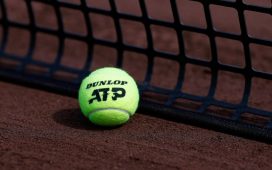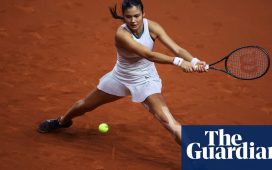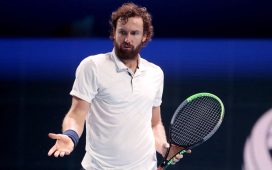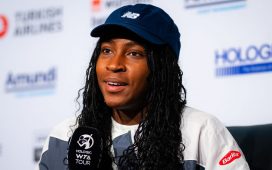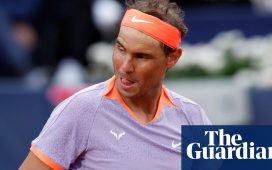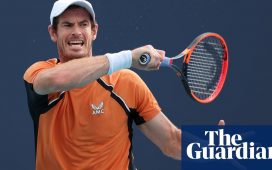Nick Kyrgios is a professional tennis player, one of the best in the world. He has an adoring girlfriend, Costeen Hatzi, and an amiable sidekick called “Horse” , as well as thousands of fans in the stands to cheer his winning shots. But it is still not enough – probably, it never quite is. “Tennis is an extremely lonely sport,” he says. “That’s what I struggle with the most.”
For better or worse, Kyrgios looks set to land a fresh load of fans with the release of the Netflix series Break Point, a 10-part docusoap that follows the fortunes of the so-called “next generation” of tennis stars; the band of twentysomething athletes who have been challenging Novak Djokovic and Rafael Nadal. These younger players all speak the same language and share the same hopes and fears (the dream of winning a big title; the terror of not fulfilling their true potential). But the logic of their profession makes them antagonists not friends. They talk to the camera but never to one another.

“I play tennis for a living even though I hate tennis,” Andre Agassi confessed in his 2009 autobiography. Mainly he hated it because it was “so damn lonely”, a repetitive grind of travel and training interspersed with fraught bursts of combat. In team sports the burden is spread and the glory is shared. Even in boxing, Agassi said, you’re at least allowed to grapple your opponent. “In tennis, though, you stand face-to-face with your enemy, trade blows with him, but never touch him or talk to him or anyone else.” His book made the sport sound positively existential. On the court, surrounded by spectators, line judges and camera crews, each player remains locked inside their own private cell.
The key difference here is that Agassi is one of the game’s all-time greats – a former world No 1; the winner of eight grand slam titles – whereas the Break Point players are still earning their spurs. They’re like mortals who have pitched camp in the foothills of Mount Olympus, gazing up at the gods with a mixture of envy and awe. Matteo Berrettini is a big-serving Italian who looks like a Latin lover from central casting; Taylor Fritz a California rich kid who dreams of winning his home tournament.
Most notably, there is Kyrgios, the combustible “bad boy” of tennis; covered in tattoos and dripping with bling. The opening episode touches on his mental health struggles and periods of heavy drinking (though it makes no mention of his 2021 charge for domestic assault). “I worry about him every day,” says Kyrgios’s mother, Norlaila. “Because he’s been through some really horrid times.”

For most of his rivals, life is probably trickier still. The sport is a virtual plutocracy. It rewards the best and starves the rest. The top 1% of players claim 60% of the annual prize money; those outside the top 100 barely earn enough to get by. Break Point’s players are the lucky ones in that they are young, gifted and comfortably in the black. And yet for some reason these people still carry the faint whiff of panic. Maybe they know the clock is ticking; they know their number of chances are finite. “This is my time,” says Berrettini as he surges to the semi-finals of last year’s Australian Open. “It’s now or never.”
Most likely it is never. Failure and disaster is built into tennis’s DNA. Probably this is what accounts for its existential frisson. Ajla Tomljanović, the Australian world No 43, points out that each tournament is effectively a zero-sum game, a Darwinian free-for-all in which a field of 32 (or 64, or 128) hopefuls is quickly, industriously reduced to just one. She says: “If you’re not winning the event you’re a loser every week. That’s when I think tennis is really brutal. It keeps going, with or without you.”

All of which makes for a bleak, bracing ride; a whirl of luxury hotels and locker rooms and brightly lit stadiums with absolutely nowhere to hide. The players follow the circus from Melbourne to Madrid, living out of suitcases and watching crap films on TV, like jaded tourists on an ill-starred cruise. They are living the dream. It resembles a nightmare.

One wonders if this was part of the original brief. In focusing on a clutch of twentysomething tennis stars, the show’s creators might have reasonably assumed that they were recording a changing of the guard, witnessing the moment these princes grew up to be kings. Except that sport is unpredictable, which is what makes it so compelling, and the best-laid plans have a habit of going awry. This, with the benefit of hindsight, appears to be what has happened to Break Point’s graduating class of 2022. History records that the Australian Open was eventually won by an ageing Nadal. The teenager Carlos Alcaraz has since been crowned as the new world No 1. So the “next generation” was leapfrogged. Its birthright has been denied. It is lost and lonely and the tour has already moved on.
The first five episodes of Break Point premiere on Netflix on 13 January. The concluding five episodes follow in June 2023.
